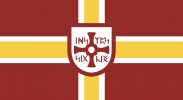Basically a Jewish analogue to the OTL Christian
Karamanlides:
Name: Khazarlides
Language: Khazarli Turkish dialect
Religion: Khazarli Judaism
Ancestry: Khazars, Anatolian Greeks, Oghuz Turks, Sephardic Jews, Balkanites
Phenotype: Anatolian, Balkan, Caucasian, sometimes Central European
Population: Unknown due to assimilation in host countries, up to several million according to some liberal estimates
Distribution: Israel, Turkey, Balkans, Russia, Western countries
Culture: Jewish, Anatolian, Balkan, Oghuz Turkic
History: The Khazarlides (Hazarlılar) are a Jewish Oghuz Turkic people whose traditional homeland is west-central Anatolia mainly concentrated around Lake Tuz in Ankara, Konya, and smaller neighboring provinces of Turkey. Whether or not they are a subgroup of the greater Jewish nation of an entirely different ethnic group of their own is still up to debate by contemporary historians and ethnographers, but they have a unique culture which differentiates them from other Turkish people, including the unique Khazarli dialect, otherwise known as Judeo-Turkish, which is a variety of the Turkish language written in the Hebrew alphabet with considerable vocabularic borrowing from Hebrew.
Their ethnonym derives from the medieval Khazars, an Oghur Turkic people who established a powerful trading empire in Eastern Europe, the Pontic-Caspian steppe, and Ciscaucasia in the Early Middle Ages that eventually converted to Judaism to secure its independence from its neighbors, the Christian Byzantines and Muslim Arabs. Although the Khazarlides claim direct descent from the Khazars, particularly from Khazar refugees who fled to Anatolia in the 10th century following the destruction of the Khazar state by Kievan Rus, their true ethnic origins are still heavily debated to this day. Another theory conjectures that the Khazarlides are actually descended from voluntary Jewish converts among Anatolian Greeks and Oghuz Turks in the High Middle Ages, who eventually adopted the Turkish language, although this postulate too has yet to be historically confirmed.
Following their emergence in Asia Minor in the 11th century, the Khazarlides eventually abandoned their original Khazar language for Medieval Greek and Old Anatolian Turkish, transitioning from Oghur to Oghuz Turkic, although they refused to convert to Christianity or Islam, retaining their Jewish faith. Despite being religiously Jewish, culturally they assimilated into Seljuk, Rum, and later Ottoman society, adopting many customs of the Oghuz Turks and militarily contributing to the eventual conquest of the Byzantine Empire. In the early modern era, a wave of Sephardic Jews fleeing the Inquisitions in Iberia came into contact with the Khazarlides, with some Sephardim eventually assimilating into their host Judeo-Turkish population. From the 16th to the 19th centuries, the Khazarlides, along with the Sephardim, Greeks, and Armenians were the richest and most loyal minorities in the Ottoman Empire, controlling much of the commerce, finance, and trade of the Sublime Port, and it was during this time that many of them settled in the Balkans and Crimea, mixing with Ashkenazim/Romaniotes in the former and Karaites/Krymchaks in the former.
The decline of the Ottoman Empire and the spread of romantic nationalism from Western Europe led to a national revival among the Khazarlides, who looked to a glorious medieval past in their ancestral state of Khazaria when they were the masters of the steppe. Many Khazarlides immigrated to Russia, particularly the North Caucasus, which they believed to be a spiritual return to their homeland, in turn living alongside and culturally borrowing from the Cossacks, Circassians, Vainakhs, Mountain Jews, and other North Caucasian peoples, although the vast majority of them remained in the Balkans and Anatolia. Others were some of the first Eastern European immigrants to the United States, in a time when African-Americans didn't even have full rights and non-Protestants were believed to be inherently biologically inferior. And of course, Zionism swept across the Karamanlides like wildfire, with thousands of them taking part in the initial Jewish settlement of Palestine.
Come around the Great War, and with the Ottomans being on the losing side, the Central Powers, mass migrations of Khazarlides from the Balkans to the newly-established Republic of Turkey took place, even if many of them had been peacefully there for hundreds of years. Come around the Second World War, and the Nazi conquests led to even more mass migrations to Turkey. To say nothing of Stalin's brutal deportations of Khazarlides in the North Caucasus to Siberia and Central Asia, as well as the massive aliyah of Soviet Jews to Israel after of the fall of the Iron Curtain at the end of the 1980s. All in all, the Khazarli people had it really rough in the 20th century, being forced to move around all over the place by necessity of the harsh regimes that they lived under.
Today, Khazarlides are well integrated in most if not all countries they live in, whether it be Israel, Turkey, the Balkans, Russia, or their immigrant communities in Western countries. They have a rich cultural heritage stretching back centuries with lots of stories to tell, and have traditions of hospitality where in some cases they treat foreigners even better than they treat themselves!
